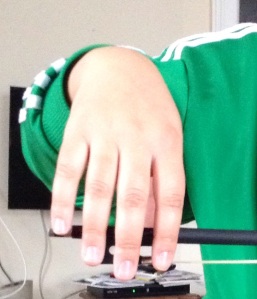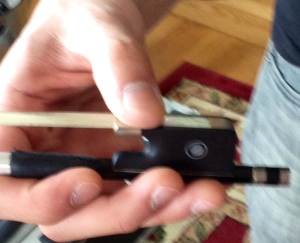Rosin is actually ‘resin,’ a sap which comes from trees like pine and conifer. Some students will be surprised when first trying to play their violin if there is no rosin on the bow because the violin will not make a sound! Rosin has a tacky feel, causing the bow hair to ‘stick’ to the string causing the string to vibrate. This reaction happens when the bow is moved across the string and amazingly a sound is produced! Once bow hold is learned, player can begin to rosin bow.
1. Before rosining the bow, begin by tightening the bow hair so there is a distance of approximately ½ inch between the hair and bow. The stick should still be able to maintain arch in it’s shape. When the bow is tightened too much the arc becomes tight and straight. This also hampers good bow technique.

2.Using left hand, take bow at midpoint so right hand is free.
3.Bend right elbow as right hand is brought in front of frog so fingers dangle.
4.Dangle right hand over frog, allowing fingers to relax.
5.Place thumb underneath bow. This is a beginner hand position and will eventually be modified so the thumb rests in the groove where bow and frog meet. (Figure 2)
6.Flip hand back around and begin to rosin bow back and forth. Be sure to cover all parts of bow hair, beginning at frog, to middle then tip of bow.
7.Be sure there’s sufficient rosin on all part of the bow hair. Avoid touching the bow hair with fingers because oil from the skin will dampen the effectiveness of the rosin on the hairs.


